skip to main |
skip to sidebar
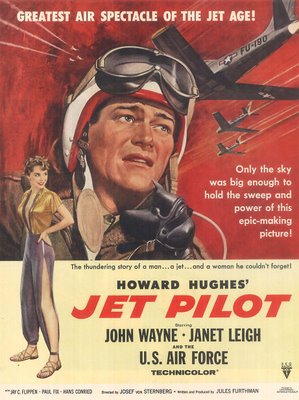

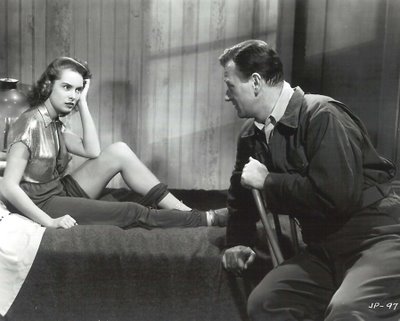 Some "Bad" John Waynes On DVD --- Part 2Jet Pilot’s long been a handy receptacle for critical derision --- the butt of a hundred old movie jokes, forever tied to the whipping post along with The Conqueror. It’s pure reflex that cites these two as John Wayne’s all-time worst. For years, they were impossible to see. During Howard Hughes’ lifetime, he kept them out of circulation. A few prints of Jet Pilot traveled among collectors, but it would be well into the eighties before either would see daylight on TV or video. Having it available on DVD may not rehabilitate its tarnished reputation, but at least we can enjoy what is at times a visually stunning show, featuring one of the most breathtaking glamour turns this tired old viewer has ever seen. Jet Pilot was meant to be the next Hell’s Angels. Howard Hughes wanted to go the old picture one better by staging bigger and better dogfights with jets instead of bi-planes. He started in 1949, and obsessed over it for the next eight years. By the time Universal released Jet Pilot in September 1957, it was an old movie, with older airplanes. Even the biggest campaign in U-I’s history couldn’t save this one from critical drubbing and disastrous word-of-mouth. In the end, Hughes took back the negative and spent most of the next two decades watching it by himself on a tabletop projector. It ended up being the most expensive home movie ever made.
Some "Bad" John Waynes On DVD --- Part 2Jet Pilot’s long been a handy receptacle for critical derision --- the butt of a hundred old movie jokes, forever tied to the whipping post along with The Conqueror. It’s pure reflex that cites these two as John Wayne’s all-time worst. For years, they were impossible to see. During Howard Hughes’ lifetime, he kept them out of circulation. A few prints of Jet Pilot traveled among collectors, but it would be well into the eighties before either would see daylight on TV or video. Having it available on DVD may not rehabilitate its tarnished reputation, but at least we can enjoy what is at times a visually stunning show, featuring one of the most breathtaking glamour turns this tired old viewer has ever seen. Jet Pilot was meant to be the next Hell’s Angels. Howard Hughes wanted to go the old picture one better by staging bigger and better dogfights with jets instead of bi-planes. He started in 1949, and obsessed over it for the next eight years. By the time Universal released Jet Pilot in September 1957, it was an old movie, with older airplanes. Even the biggest campaign in U-I’s history couldn’t save this one from critical drubbing and disastrous word-of-mouth. In the end, Hughes took back the negative and spent most of the next two decades watching it by himself on a tabletop projector. It ended up being the most expensive home movie ever made.
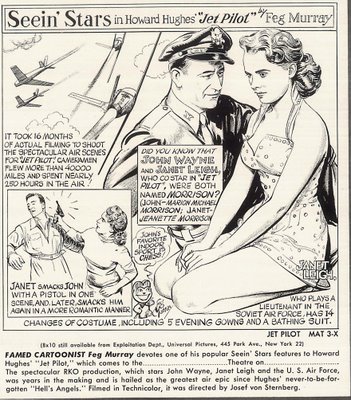
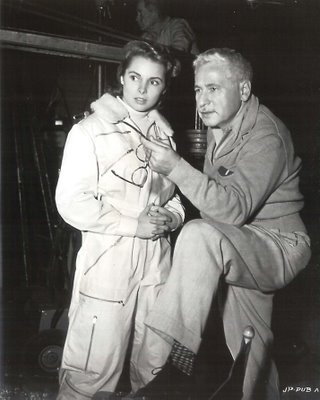
Robert Mitchum was originally set for the lead in Jet Pilot. Wayne stepped in after signing a multi-picture deal with Hughes. They were buddies off-screen. Howard wanted to be Duke, and Wayne couldn’t help being impressed with a man so powerful he could seemingly make clocks stop at will. Shooting began on Halloween 1949 under the direction of cast-off tyro director Josef Von Sternberg, whose comeback was breathlessly reported by lifelong acolyte Herman G. Weinberg in The New York Times. My films were protests against other films at the time, said the master craftsman after eight years in cinematic Siberia, and worship-the-ground-he-walked-on Weinberg was tactful enough to omit satchels full of anecdotes detailing Jo's on-set tyranny and abuses --- but even this Captain Bligh with a megaphone was no match for Hughes’ controlling ways. Sternberg (shown here with Janet Leigh and on the crane directing a dance sequence) wasn’t involved with the flying shots in any case. Multiple second units shot those on a total of fourteen different air bases from Alaska to Florida. Sixteen initial months were given over to the aerial stuff, and there’s reason to believe Hughes continued gathering jet footage beyond even that. MGM head Dore Schary had loaned Janet Leigh to co-star, but he never dreamed this project would drag so far into the next decade. He would later recall Hughes’ request for Janet’s further services --- seems Howard wanted retakes on Jet Pilot --- three years after principal photography had ended. I have had my bellyfull, said Hughes to Schary shortly before the show was finally released, and indeed this would be his final project before the cameras.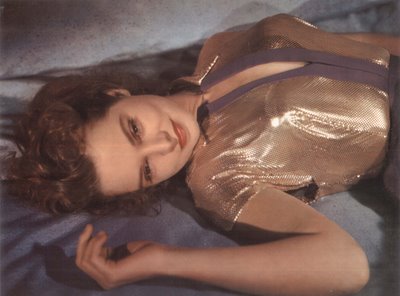
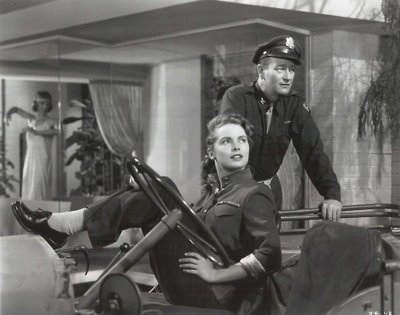
Anybody else would have wanted this one wrapped up A.S.A.P. --- seeing as how the jet fad wasn’t going to last forever --- but Hughes dawdled while Chain Lightning, Breaking The Sound Barrier, and other supersonics took to the skies. Despite his occasional updating of the flight footage (which, of course, no one had seen), similar projects flew away with Jet Pilot’s potential audience. Press releases and gossip continued to appear as the fifties wore on, but Hughes wouldn’t let it go. Sternberg had long since been booted off the project --- Wayne oft expressed a desire to "kill the sonofabitch." --- pinch-hit directors Nicholas Ray and Jules Furthman (who’d also been associate producer and writer) were brought aboard for the seemingly endless retakes. When Universal finally took custody (Hughes having sold RKO in the meantime), they wisely opted for saturation release with a whopping 400 prints opening day-and-date (the better to get patron’s money before a stench got out). Commenting on years of press coverage now in the morgues, Jet Pilot's pressbook openly inquired of showmen, How much of this penetration has been retained --- How much of it has faded with time? Harrison’s Reports said Universal was spending unprecedented dollars on a new campaign. I wonder how much of this Hughes footed. Critics were merciless, as expected, commenting on how "youthful" the two stars looked in a now ancient vehicle (must have made Janet feel good reading those reviews). Others observed that the planes were "obsolete and out of date" (as if they’d know the difference between a B-45 and a dill pickle). What may have wounded Hughes most were harsh comparisons between Jet Pilot and Paramount’s recent Strategic Air Command, which had the benefit of up-to-the-minute air technology and Vistavision in the bargain. Panoramic projection had become a must since bygone days when Jet Pilot was in production, but U-I solved that by going with ersatz wide prints that played havoc with Sternberg’s elegant compositions. Later 16mm prints and videos were full-frame as intended, but Universal’s new DVD goes back to 1.85. Too bad. They could have at least offered it both ways.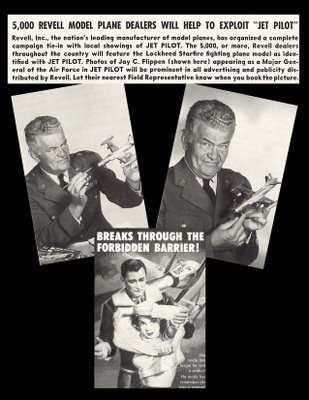
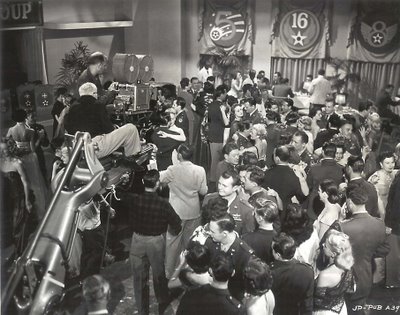
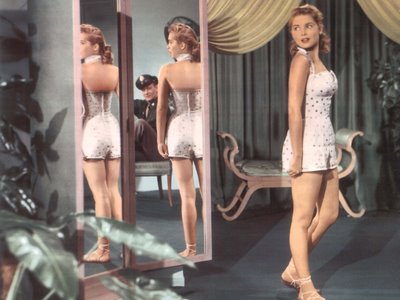
Sixties and thereafter critics speak of Jet Pilot in terms of "cold war hysteria." "Piquant Howard Hughes sex farce" is how I prefer to think of it. I’m betting he got together with Howard Hawks on some of the gags and situations in this show. More than once, I was reminded of The Thing (which RKO would have been shooting at the same time). Janet Leigh’s renegade Russian flyer might just as easily have touched down at Captain Hendrys airbase, leaving that titular super-carrot to bedevil John Wayne and Paul Fix. Imagine Kenneth Tobey engaged in saucy repartee with Janet! As it is, there’s a scene in both pictures where guys enter a room from the frigid outside, being admonished by those within to "Close the door!" He may have been the biggest yank-off in town, but Jo Von Sternberg knew a thing or three about photography and direction. Everything he did for Dietrich in the thirties is surpassed here --- only this time it’s in color. Howard and Jo are a great team in Jet Pilot, whatever you may have heard to the contrary. For every blandishment he got about Jane Russell, this is where Hughes really delivered on the sex. Every close-up of Janet Leigh is drop-dead incredible. Never mind cold war hysterics. Buy it just to look at her. Jet Pilot is too stupid and raunchy for most critical sensibilities. The dialogue’s reminiscent of those Playboy Party Jokes we used to read on the back of the centerfolds, and all the more unsettling to hear John Wayne delivering it. He’s a lot like Clark Gable taming Hedy Lamarr in Comrade X, only smuttier and more direct. You’d expect him to eventually chuck the love stuff and get on with mopping up commies, but the sex pursuit remains front and center throughout. Hughes just didn’t find anything else remotely as interesting, and neither did I --- which brings us to those celebrated airborne scenes. Those are the real drag. None of these jets ever get in a fight. They just fly aimlessly about to no good purpose. I never understood what they were supposed to be doing up there, other than looking for fluffy clouds to serve as an arresting backdrop. I kept waiting for them to land so maybe Janet Leigh would take another shower. Have I sold you on this picture yet? Don’t imagine for a moment that it’s "good." Nothing of the kind, but if you’re looking for a warm-up to that big Ford/Wayne box set coming next week, you could do a lot worse than this.



 Looking Back At Wartime LobbiesThat first anniversary of Pearl Harbor found theatre lobbies dressed out with every conceivable lure for patrons to aid in the war effort. The "Victory Booth" was a common sight, as showmen were among the most effective bond salesmen. Those patriotic features, shorts, and newsreels didn’t go for naught. Audiences were besieged with solicitations before they even got through the front entrance. This scrap collection display on the sidewalk threatens to overwhelm the rather prosaic marquee in back of it --- the idea of tossing refuse into the open mouths of our enemies seems to have been effective, as one can envision parents lugging the stuff into theatres, then letting their kids have fun playing ring toss with Adolf. Day and night service at these bond counters was no idle promise. Many houses maintained round-the-clock schedules to accommodate third shift war workers anxious to catch the latest Andy Hardy before heading home for some a.m. shuteye. I bet non-participants really got the fish eye whenever giving those booths the go-by. Civilian slackers were no more to be tolerated than able-bodied men out of uniform, and the pressure to buy bonds and kick in on scrap drives must have been enormous. Even the happy prospect of seeing The Boogie Man Will Get You on a giant theatre screen would diminish somewhat in the face of contemptuous looks from expectant managers, ushers, and candy butchers, all of them conveying silent disapproval as you arrive sans scrap and leave minus bonds. I’ll bet they even took names in some of the smaller towns.
Looking Back At Wartime LobbiesThat first anniversary of Pearl Harbor found theatre lobbies dressed out with every conceivable lure for patrons to aid in the war effort. The "Victory Booth" was a common sight, as showmen were among the most effective bond salesmen. Those patriotic features, shorts, and newsreels didn’t go for naught. Audiences were besieged with solicitations before they even got through the front entrance. This scrap collection display on the sidewalk threatens to overwhelm the rather prosaic marquee in back of it --- the idea of tossing refuse into the open mouths of our enemies seems to have been effective, as one can envision parents lugging the stuff into theatres, then letting their kids have fun playing ring toss with Adolf. Day and night service at these bond counters was no idle promise. Many houses maintained round-the-clock schedules to accommodate third shift war workers anxious to catch the latest Andy Hardy before heading home for some a.m. shuteye. I bet non-participants really got the fish eye whenever giving those booths the go-by. Civilian slackers were no more to be tolerated than able-bodied men out of uniform, and the pressure to buy bonds and kick in on scrap drives must have been enormous. Even the happy prospect of seeing The Boogie Man Will Get You on a giant theatre screen would diminish somewhat in the face of contemptuous looks from expectant managers, ushers, and candy butchers, all of them conveying silent disapproval as you arrive sans scrap and leave minus bonds. I’ll bet they even took names in some of the smaller towns.
The above posting is number 200 for Greenbriar Picture Shows. We’ve been here since December 27, 2005, and the only day we’ve missed was when the server broke down (in the beginning, there were sometimes three posts in a day!). All 200 of these stories are in the archive, and you can link to it anytime from the top of this main page or by going HERE. The drop-down search engine has individual options for names, movie titles, and categories (for instance, our Glamour Starters series has its own section, as does Horror, Comedy, Musical, etc.). Go there sometime if you haven’t already.
 Some "Bad" John Waynes On DVD --- Part 1
Some "Bad" John Waynes On DVD --- Part 1
 With all the excitement and anticipation focused on the forthcoming John Ford/John Wayne DVD box from Warners, it’s easy to overlook these runts in the Wayne litter, but what could Universal do? They own but a handful of Wayne titles, so its catch-and-catch-can on their own John Wayne --- An American Icon Collection. I’ve just looked at some harsh customer reviews on Amazon. They advise against purchase of these five obscurities. But don’t listen to these sourpusses ... go buy this neglected and woebegone group today! They’re the ones to best illustrate fabled ups and downs in a career with as many false starts and appalling role selections as any major star ever got away with over fifty working years. There’s not a one that won’t fascinate you --- they sure did me. Despite my expressed reservations to come, I thoroughly enjoyed seeing them again. Yes, it’s easy to admire Wayne in She Wore A Yellow Ribbon and The Searchers, but after three dozen or so rounds with those acknowledged classics, there’s a real sympathy factor that kicks in for deer-in-headlights uncertainty he projects in these early almost-leads. JW's near-heroic blending of resignation with a get-it-done determination as displayed in Jet Pilot and The Conqueror makes us admire indomitable Wayne spirit all the more. I only wish Universal would stupefy naysayers and give us really obscure John Wayne titles, as they own several --- Idol Of The Crowds, California Straight Ahead, etc. --- that would truly be something to see!
With all the excitement and anticipation focused on the forthcoming John Ford/John Wayne DVD box from Warners, it’s easy to overlook these runts in the Wayne litter, but what could Universal do? They own but a handful of Wayne titles, so its catch-and-catch-can on their own John Wayne --- An American Icon Collection. I’ve just looked at some harsh customer reviews on Amazon. They advise against purchase of these five obscurities. But don’t listen to these sourpusses ... go buy this neglected and woebegone group today! They’re the ones to best illustrate fabled ups and downs in a career with as many false starts and appalling role selections as any major star ever got away with over fifty working years. There’s not a one that won’t fascinate you --- they sure did me. Despite my expressed reservations to come, I thoroughly enjoyed seeing them again. Yes, it’s easy to admire Wayne in She Wore A Yellow Ribbon and The Searchers, but after three dozen or so rounds with those acknowledged classics, there’s a real sympathy factor that kicks in for deer-in-headlights uncertainty he projects in these early almost-leads. JW's near-heroic blending of resignation with a get-it-done determination as displayed in Jet Pilot and The Conqueror makes us admire indomitable Wayne spirit all the more. I only wish Universal would stupefy naysayers and give us really obscure John Wayne titles, as they own several --- Idol Of The Crowds, California Straight Ahead, etc. --- that would truly be something to see!


Seven Sinners is a Code-addled, would-be lampoon of much better shows played straight in the early thirties. It spoofs the Marlene Dietrich of Shanghai Express out of necessity of placating the PCA. Instead of Clive Brook, we get Mischa Auer. Warner Oland becomes Billy Gilbert. Dietrich had to know her act was being denuded. Male consorts are now feckless eunuchs, seemingly incapable of achieving sexual congress with any woman, let alone Marlene’s siren of the tropics. She’s been run out of every port for "inciting riots" and questionable character, but lunkhead camp follower Broderick Crawford assures us (and censors) that Bijou is a lady and buys her own dresses (presumably to establish that she’s nobody’s mistress). As with the prototype Dietrich hit of the previous year, Destry Rides Again, everything is pitched decidedly low for comedy. There's aforementioned Mischa Auer, Billy Gilbert, Vince Barnett, Brod Crawford --- everyone, it seems, but Shemp Howard. They’re all straining to be funny and deflect any audience notion that Marlene may intend to have, or has had, sex with anyone. Romance with youthful John Wayne, besides the usual May/December concerns (she was nearly six years his senior, and looks more so), is laughably chaste, his last reel "sacrifice" on her behalf altogether pointless and nonsensical in view of their abstinence. Wayne had just broken into "A’s" by 1940, and director Tay Garnett seems content to let the relatively inexperienced actor go his own way. JW's playing it like one of the Three Mesquiteers, and there are moments when you wish a Ford or a Hawks would come in and crack the whip on him. Still, he’s good in a boyish way, and Dietrich’s customary seduction of her leading men seems to have carried on for Wayne’s benefit, though I can’t imagine what these two would have had to talk about (that may not have been an issue in any case, as JW referred to Dietrich late in life as "the best lay I ever had").




If Ozarkians were really as anti-social as they appear in Shepherd Of The Hills, you wonder how they managed to reproduce. This first time in Technicolor John Wayne still finds him among a performing ensemble, as in Stagecoach and The Long Voyage Home. Thank heaven he forfeits any attempt at a Southern accent. That’s always death to us real-life cornpones hoping for realistic depictions of mountain culture. Moonshining is an initial narrative focal point, dumped summarily in favor of feud palaver I never fully comprehended. Everyone’s so down in this --- never was there such a morose lot of hillbillies. The only tilt at humor is a donnybrook where Wayne gets conked in the head and, perhaps for the first time, does the cross-eyed comic take later to be so overworked. Big Bear Lake and the San Bernardino Mountains stand in for locations, and this is truly some of the best Technicolor I’ve seen rendered on DVD. Betty Field is way sexy as sole eligible female amongst the clans. She’s reason enough to have Shepherd Of The Hills, despite dialogue laden with stix-flavored mannerism (there’s nothing more irritating than self-consciously verbose rural philosophers forever clarifying everything they say with some off-putting analogy --- either in movies or real life). Surprising is fact robust mountaineers (Ward Bond among them) aren’t fighting like wildcats over Betty instead of meekly ceding her to Wayne. You keep wishing he’d grab the gal (They’ll be no locks nor bolts between us) and get on with a consummation. As it is, we’re dealing yet with Wayne the juvenile, his screen persona still not fully formed, so mild audience frustrations are more keenly felt by us in hindsight than would have been the case for 1941 viewers.



I’m all for comeuppance on the screen when it’s deserved. Gary Cooper filled Karl Malden full of holes at the end of The Hanging Tree, kicked him off the side of a mountain, and that was fine. Frenchie needed killing. On the other hand, there are shows where humbling gets excessive. John Wayne eats much crow in Pittsburgh, served up by a gallery of insufferable prigs we like far less than Duke’s overreaching coal tycoon. They’re punishing him for failure to join the group effort --- everyone’s shoulder to a common wheel --- and basis for all wartime preachment circa 1942. If it won’t help win the war, forget it! reads a banner we see as the picture opens on Randolph Scott's rah speech to munitions staff, words no doubt hammered into Universal scribes con-fabbing daily with military consultants assigned by the Office Of War Information. Never were films so compromised by outside dictates and policy as during this conflict. Even reviewers of the time lamented heavy dollops of propaganda inherent to virtually all Hollywood output. Any screen character reluctant to pull collective weight was brought to heel. It’s no fun seeing go-getter Wayne bow to OWI policy, but there was a war on, and big business freebooters of the Wayne/Pittsburgh/Gable/Boom Town pattern suggested profiteering more than patriotism, and thus needed harnessing for the good of all. Duke’s like a forerunner to Jett Rink, minus whining and sucker punches, and this being Universal, gets Louise Allbritton for a wife, plus Samuel S. Hinds for a father-in-law (his avuncular presence an absolute given in any motion picture bearing a Universal logo). Might we all petition the company to get started on a nineteen volume Samuel S. Hinds Legacy Collection? Leading lady Marlene Dietrich looks matronly beside youthful Wayne, burdened as she is with cumbersome "fashions." Was a woman ever so overly coiffed as Dietrich? One fur collar threatens to swallow her head. It seems she's changed outfits between one end of a corridor and the next. Dietrich would not be the only aging actress consumed by prevailing styles as passing years made her otherwise less relevent.
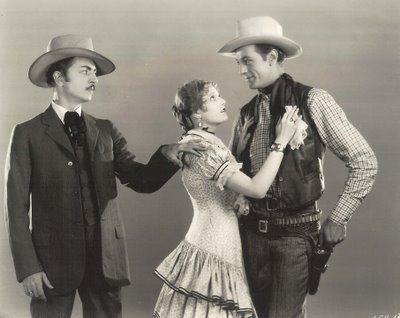
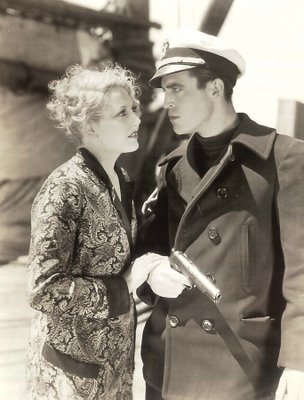
 Monday Glamour Starter --- Thelma ToddIf there are any ninety-year old readers prepared to finally confess in the matter of Thelma Todd’s unsolved 1935 murder, we are ready, indeed anxious, to take your statement. Having waited seven decades to get this thing cleared up, I’d like to close the file on this one (not that anyone has access to the original investigation paperwork, it having disappeared generations ago as part of the "cover-up"). Whatever else she may have accomplished, this is what Todd will be best remembered for. Just a body slumped over a car seat in the wake of what Fred MacMurray would call a "monoxide job". People still make pilgrimages to her garage (it’s still there) and there have been wildly differing theories as to what happened to Thelma. I say it was just a grotesque accident --- involuntary manslaughter at best --- with the presumed miscreant, and all his friends and associates, having been dead for so long as to make the possibility of further clarification all but impossible. We might as well go back and try again to unmask Jack The Ripper. The little bit of Thelma Todd that’s left in the public consciousness, once you take away the mystery, is a handful of appearances with comedians whose names have survived, and the woman must have been doing something right, because she worked with some greats. There was even a Thelma Todd starring series at Hal Roach --- two-reel comedies in which she and ZaSu Pitts (later Patsy Kelly) paired off as a kind of distaff Laurel and Hardy. The fact these comedies are all but impossible to see now is courtesy of Hallmark Cards, regrettably still in custody of the Roach library. The Todd/Pitts/Kelly shorts were a real trail mix of mirth and tedium --- some of them are pretty funny, others sheer torture --- all fascinating. Zazu’s easier to take than Patsy. Even a subdued Patsy (and Patsy was never subdued) is akin to root canal without benefit of anesthesia, but at least there’s Thelma, and she’s always a welcome sight, especially on those occasions when she effects costume changes on camera, and there were happily lots of those …
Monday Glamour Starter --- Thelma ToddIf there are any ninety-year old readers prepared to finally confess in the matter of Thelma Todd’s unsolved 1935 murder, we are ready, indeed anxious, to take your statement. Having waited seven decades to get this thing cleared up, I’d like to close the file on this one (not that anyone has access to the original investigation paperwork, it having disappeared generations ago as part of the "cover-up"). Whatever else she may have accomplished, this is what Todd will be best remembered for. Just a body slumped over a car seat in the wake of what Fred MacMurray would call a "monoxide job". People still make pilgrimages to her garage (it’s still there) and there have been wildly differing theories as to what happened to Thelma. I say it was just a grotesque accident --- involuntary manslaughter at best --- with the presumed miscreant, and all his friends and associates, having been dead for so long as to make the possibility of further clarification all but impossible. We might as well go back and try again to unmask Jack The Ripper. The little bit of Thelma Todd that’s left in the public consciousness, once you take away the mystery, is a handful of appearances with comedians whose names have survived, and the woman must have been doing something right, because she worked with some greats. There was even a Thelma Todd starring series at Hal Roach --- two-reel comedies in which she and ZaSu Pitts (later Patsy Kelly) paired off as a kind of distaff Laurel and Hardy. The fact these comedies are all but impossible to see now is courtesy of Hallmark Cards, regrettably still in custody of the Roach library. The Todd/Pitts/Kelly shorts were a real trail mix of mirth and tedium --- some of them are pretty funny, others sheer torture --- all fascinating. Zazu’s easier to take than Patsy. Even a subdued Patsy (and Patsy was never subdued) is akin to root canal without benefit of anesthesia, but at least there’s Thelma, and she’s always a welcome sight, especially on those occasions when she effects costume changes on camera, and there were happily lots of those …
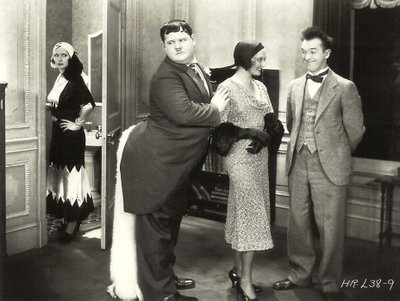
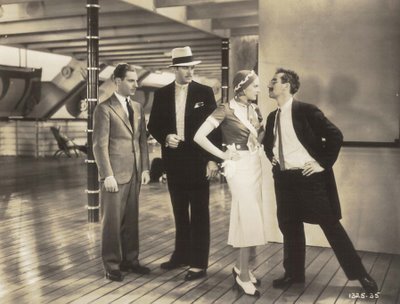
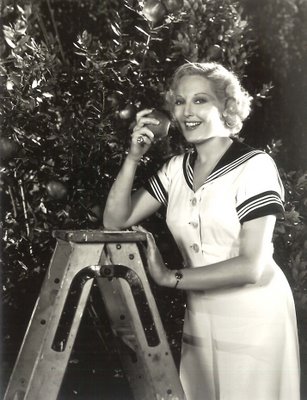
There’s a Thelma Todd celebration coming up in Manchester, New Hampshire on July 27, 2006. You can read about it HERE. Manchester is only thirty miles from Thelma’s birthplace in Lawrence, Massachusetts. She was born a hundred years ago this year, and they’ll be celebrating her birthday on July 29. There was a New England cousin who’d spent her life collecting on Thelma. When she died, they had an auction of all the memorabilia, and some newspaper sent down one of those I’m a well-adjusted writer with a normal life who’s come to interview all these geeks and wierdos at the old movie sale type articles. Very condescending, as is most of mainstream media’s coverage of such events. Always kind of sad when the product of a lifetime’s effort is so callously disposed of, but that’s the bittersweet, if not inevitable, finish for all collectors (and their collections). Thelma herself had cleared out of Lawrence by the time she was twenty, gone to Hollywood with an armload of loving cups from various Lion’s Clubs and the promise of stardom to come. That was slow in arriving, as there were tens of thousands out there just like her, but after an uncertain start with ingenue roles (here’s one of them --- Thelma with a young Gary Cooper and rival William Powell in 1927’s Nevada) she lucked into comedy parts. This was a niche conventional actresses on the rise were less ambitious to fill --- indeed she was typecast from then on, and efforts to drama-tize Thelma, even to the point of giving her a new name (Alison Loyd) were doomed to failure. Corsair with Chester Morris (shown here) was a 1931 experiment, but already Todd was so familiar in comedies that audiences wouldn’t accept her in anything else (her partner ZaSu Pitts had the same problem).
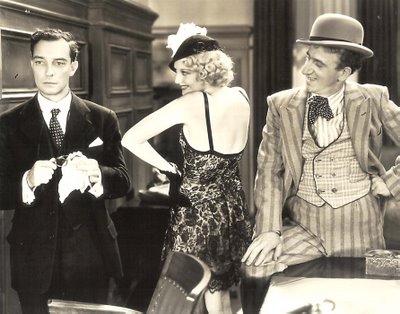
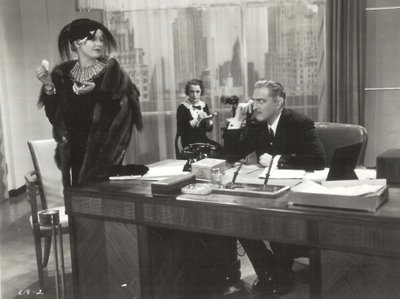
Multiple smash-ups, both on account of drinking and ongoing lack of motoring skills, nearly got Thelma killed (a palm tree jumped out in front of her car on one occasion), but she managed to get into a lot of product before that night in December 1935 when the lights went out. Without going into Byzantine detail, let’s just say that Thelma’s death has never been satisfactorily explained. The maid found her dead in the garage, with no signs of violence (some theorists differ on that point), and evidence indicated she’d perished amidst the fumes of her car engine. Had Thelma gone there during the chilly night to warm up? There’d been a fight with live-in Roland West (former major director down on his luck, but well connected in Hollywood power circles), and he’d banished her from the house. There’s convincing evidence he followed her down to the garage and locked her inside, but no indication she’d struggled to get out. In fact, Todd was found in the front seat. West supposedly went down the next day to check on her and found the grisly result of having sealed that door the night before. From there, it was just a matter of waiting out the discovery by an innocent third party, then feigning surprise when told. Investigators even got a confession out of Roland West, but all that was deep-sixed "for the good of the industry." Shortly before his own death in 1952, West spilled it again to close friend Chester Morris, and Morris eventually passed it along to Alex Gordon and Bill Everson. All this sounds a lot more plausible than another Todd biographer who asserts that Thelma was offed by Lucky Luciano's mob after she’d gotten mixed up with the notorious racketeer and killer. That’s the story that’s gotten the most airplay, and it’s admittedly made to order for the Mysteries and Scandals viewership, but I prefer the West angle. On the other hand, as I posited at the beginning, we may be addressing the (elderly) killer with this very post, and I may indeed be jeopardizing my own life by even exploring the matter!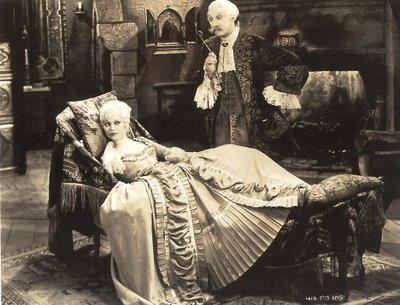
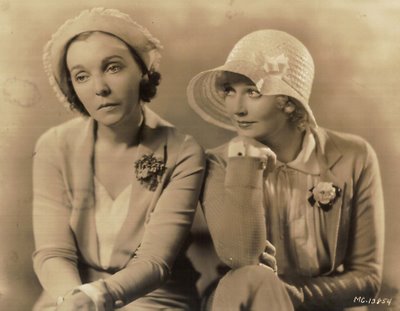

Thelma was known as the "ice cream blonde" ("… and everyone wanted a lick" must surely have been a refrain on the lips of various Hollywood lotharios). This negligee shot with the phone is from the 1931 version of The Maltese Falcon (her part in the remake was played by Gladys George!). Laurel and Hardy benefited from Thelma’s presence in several shorts --- too bad there weren’t more --- this one is Chickens Come Home, and she’s gorgeous in it. Monkey Business was one of two Marx Brothers features in which she participated. The other was Horse Feathers, but that one was code-cut in the late forties, and what’s left of Thelma’s key scene with the Brothers is so mutilated as to be almost incoherent. Too bad Universal hasn’t been able to locate better elements on this 1932 release. Buster Keaton was near a point of no return when Speak Easily found him sharing scenes with Thelma. This office exchange with John Barrymore in Counselor At Law also fell before the Code’s ax for a 1953 re-issue --- what’s left is still fine, but this missing footage appears to be gone forever. That's James Finlayson as a suspicious husband in The Devil’s Brother, and ZaSu Pitts poses with Thelma for a portrait heralding another Hal Roach short comedy. Their two-reelers generally ran ahead of Our Gang and The Boy Friends in terms of rentals, but behind Charley Chase and of course, the Laurel and Hardy series, which was the biggest earner of all. Hard to imagine them beating out Roach’s Rascals, considering how forgotten the Todd/Pitts shorts are today. This final image is something of a rarity --- Thelma Todd in The Bohemian Girl, a feature just completed at the time of her death. Preview audiences apparently saw Thelma, but hasty reshooting in the wake of her mysterious death found the part recast and virtually all her footage removed. This sequence with Antonio Moreno was not seen by the public, and very few stills of Thelma from this film have been published --- in fact, the only other one I’ve seen is in Randy Skretvedt’s excellent book, Laurel and Hardy: The Magic Behind The Movies.
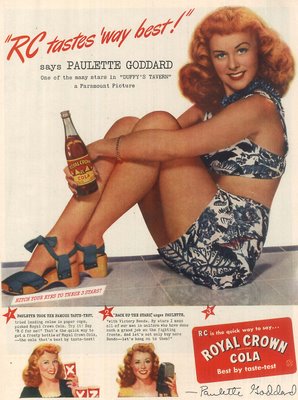


 They Drink RC Even As You and ISo many cola choices, but only one wins the taste test hands down, and that’s Royal Crown, the favorite of discerning actresses throughout our great industry. Rita seems the odd one out, having picked the cup labeled "Z" while Paulette and Hedy both went for that "X" container. Could Rita have selected a Pepsi in the belief it was an RC, or did someone switch beverages on the chance that the girls might get together and brief one another as to which they should choose? What if all three cups were filled with Royal Crown, in which case one must challenge the legitimacy of the whole exercise. It’s even possible that none of these three choices actually contained RC, but were instead filled with Coca-Cola (or even dreaded also-ran "Spur" cola) --- a cruel bit of japery on the part of bored and cynical ad agency employees determined to prove once and for all the indiscriminate, plebian tastes of overpaid, undereducated movie stars. We’re sixty years too late to get to the root of what appears at best a suspicious, and possibly corrupt, enterprise. We can only recommend you decide for yourself --- conduct your own cola taste test perhaps, and be sure to let us know the results ...
They Drink RC Even As You and ISo many cola choices, but only one wins the taste test hands down, and that’s Royal Crown, the favorite of discerning actresses throughout our great industry. Rita seems the odd one out, having picked the cup labeled "Z" while Paulette and Hedy both went for that "X" container. Could Rita have selected a Pepsi in the belief it was an RC, or did someone switch beverages on the chance that the girls might get together and brief one another as to which they should choose? What if all three cups were filled with Royal Crown, in which case one must challenge the legitimacy of the whole exercise. It’s even possible that none of these three choices actually contained RC, but were instead filled with Coca-Cola (or even dreaded also-ran "Spur" cola) --- a cruel bit of japery on the part of bored and cynical ad agency employees determined to prove once and for all the indiscriminate, plebian tastes of overpaid, undereducated movie stars. We’re sixty years too late to get to the root of what appears at best a suspicious, and possibly corrupt, enterprise. We can only recommend you decide for yourself --- conduct your own cola taste test perhaps, and be sure to let us know the results ...

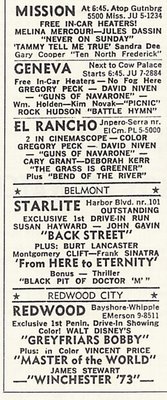 A Recipe For DestructionCourtesy among competing showmen was a thing fast disappearing by the sixties, when the decline in attendance, coupled with television’s ongoing encroachment, forced theatres to adopt ruinous booking policies --- an exhibitor’s hara-kiri with first-run features the weapon of choice. NBC had just introduced a Fall lineup of blockbuster post-48 movies on Saturday evenings, and syndicated packages of recent releases gave viewers plenty of reason to stay home nights. Desperate exhibitors retaliated by front-loading their marquees with triple helpings --- drive-ins were particularly at fault. This first ad presents the outdoor theater menu for a weekend in December of 1961. These were big new pictures at the top of the bill --- The Guns Of Navarone was a June release and still a viable attraction for the hardtops. Here it’s lumped with two other features (Bend Of The River must have been nice on that big screen) for a show that tipped the clock at seven hours plus. Five years later, things were worse. Now they were serving four shows, and for only a dollar a car! Trade press editorials fulminated against this eat-or-be-eaten policy. It was no isolated incident, they said. Brand new releases were being burned off day and date between indoor and outdoor venues, only the drive-in mob was enjoying four helpings for the price of the one that downtown patrons were getting. This sample from April 1966 illustrates the bargain awaiting crowds at the Trenton Drive-In, where three of the attractions were less than three months in release. The problem was attributed to "industry-wide chaos and confusion" that resulted from the distributor’s abandonment of long established clearance and playoff patterns. Drive-in operators were "scratching each other’s eyes out", they said. A short-term bargain for the customers, but a long-term disaster for showmen. Few could have anticipated the real disaster, and the eventual near-extinction, that lay in wait for drive-ins, nor the insatiable appetite of television networks gobbling up theatrical hits before theaters could even play them off. Exhibition as we’d known it was headed for oblivion. Reading these anxious editorials can be a little sad when you realize what so many of these guys had to look forward to. At least a few of them saw it coming.
A Recipe For DestructionCourtesy among competing showmen was a thing fast disappearing by the sixties, when the decline in attendance, coupled with television’s ongoing encroachment, forced theatres to adopt ruinous booking policies --- an exhibitor’s hara-kiri with first-run features the weapon of choice. NBC had just introduced a Fall lineup of blockbuster post-48 movies on Saturday evenings, and syndicated packages of recent releases gave viewers plenty of reason to stay home nights. Desperate exhibitors retaliated by front-loading their marquees with triple helpings --- drive-ins were particularly at fault. This first ad presents the outdoor theater menu for a weekend in December of 1961. These were big new pictures at the top of the bill --- The Guns Of Navarone was a June release and still a viable attraction for the hardtops. Here it’s lumped with two other features (Bend Of The River must have been nice on that big screen) for a show that tipped the clock at seven hours plus. Five years later, things were worse. Now they were serving four shows, and for only a dollar a car! Trade press editorials fulminated against this eat-or-be-eaten policy. It was no isolated incident, they said. Brand new releases were being burned off day and date between indoor and outdoor venues, only the drive-in mob was enjoying four helpings for the price of the one that downtown patrons were getting. This sample from April 1966 illustrates the bargain awaiting crowds at the Trenton Drive-In, where three of the attractions were less than three months in release. The problem was attributed to "industry-wide chaos and confusion" that resulted from the distributor’s abandonment of long established clearance and playoff patterns. Drive-in operators were "scratching each other’s eyes out", they said. A short-term bargain for the customers, but a long-term disaster for showmen. Few could have anticipated the real disaster, and the eventual near-extinction, that lay in wait for drive-ins, nor the insatiable appetite of television networks gobbling up theatrical hits before theaters could even play them off. Exhibition as we’d known it was headed for oblivion. Reading these anxious editorials can be a little sad when you realize what so many of these guys had to look forward to. At least a few of them saw it coming.

 The Curse Of Frankenstein Would Haunt Me Forever!Kids today aren’t going to levitate over The Curse Of Frankenstein. They’d likely say it’s dull, slow, nothing happening --- the customary branding iron applied to so many old movies, particularly horror ones, where explicit gore has been industry standard for going on, what, forty years? Good luck convincing youthful doubters it was Curse Of Frankenstein that actually led the way toward wide-open charnel houses that are screen horror today. To know Curse's impact, to feel the shudders going through crowded auditoriums that summer in 1957, you really have to will yourself back --- see it through their eyes. Warners distributed this breakout Hammer film from England. They knew they had something special from the day Jack Warner first screened it. Comparisons with WB's previous horror smash, House Of Wax, were inevitable --- but showmen knew this was a radical departure from that buoyant, gay-nineties funhouse so amusing to audiences in 1953. If anything, House Of Wax was a throwback to Gentleman Jim, The Strawberry Blonde, and other nostalgia trips popular in the forties. Curse Of Frankenstein was not built for laughs nor fun. It was dirty lab jackets smeared with blood, heads cleaved off just below the frame line, eyeballs and dismembered hands daintily wrapped in burlap swatches --- all of which genuinely shocked viewers unaccustomed to such clinical laboratory detail, never mind it's being served in color. Some were disappointed by the monster’s appearance. Hammer couldn’t use the familiar Karloff visage, but Universal’s copyrighted Frankenstein conception had been more or less out of circulation for a while anyway. Comparisons would soon be made as originals took their television bow within a few months of Curse openings (July 1957), and cheapjack theatrical knock-offs Frankenstein’s Daughter and I Was A Teenage Frankenstein would follow. Soon home and theatre screens would be fairly inundated with Frankenstein product,
The Curse Of Frankenstein Would Haunt Me Forever!Kids today aren’t going to levitate over The Curse Of Frankenstein. They’d likely say it’s dull, slow, nothing happening --- the customary branding iron applied to so many old movies, particularly horror ones, where explicit gore has been industry standard for going on, what, forty years? Good luck convincing youthful doubters it was Curse Of Frankenstein that actually led the way toward wide-open charnel houses that are screen horror today. To know Curse's impact, to feel the shudders going through crowded auditoriums that summer in 1957, you really have to will yourself back --- see it through their eyes. Warners distributed this breakout Hammer film from England. They knew they had something special from the day Jack Warner first screened it. Comparisons with WB's previous horror smash, House Of Wax, were inevitable --- but showmen knew this was a radical departure from that buoyant, gay-nineties funhouse so amusing to audiences in 1953. If anything, House Of Wax was a throwback to Gentleman Jim, The Strawberry Blonde, and other nostalgia trips popular in the forties. Curse Of Frankenstein was not built for laughs nor fun. It was dirty lab jackets smeared with blood, heads cleaved off just below the frame line, eyeballs and dismembered hands daintily wrapped in burlap swatches --- all of which genuinely shocked viewers unaccustomed to such clinical laboratory detail, never mind it's being served in color. Some were disappointed by the monster’s appearance. Hammer couldn’t use the familiar Karloff visage, but Universal’s copyrighted Frankenstein conception had been more or less out of circulation for a while anyway. Comparisons would soon be made as originals took their television bow within a few months of Curse openings (July 1957), and cheapjack theatrical knock-offs Frankenstein’s Daughter and I Was A Teenage Frankenstein would follow. Soon home and theatre screens would be fairly inundated with Frankenstein product, though none of these would achieve the startling success enjoyed by Warners with The Curse Of Frankenstein. Domestic rentals totalled $1.4 million, with foreign at $1.0, for a worldwide $2.6 million. Profits for Warners amounted to a bountiful $1.6 --- fantastic money for an exploitation horror show.
though none of these would achieve the startling success enjoyed by Warners with The Curse Of Frankenstein. Domestic rentals totalled $1.4 million, with foreign at $1.0, for a worldwide $2.6 million. Profits for Warners amounted to a bountiful $1.6 --- fantastic money for an exploitation horror show.

 Curse Of Frankenstein was a natural for round the clock shows. This shot of opening night at NYC's Paramount theatre delivered on the promise of sock numbers previously counted in London (love those entrances!), and stunt ballys were all over streets in cities across the country, as sampled here. That "monster mask for the kids" doesn’t inspire much confidence, considering it’s just a blown-up paper ad mat presumably ripped to shreds the moment you tried putting it on. This comic version of Curse Of Frankenstein was actually published in 1964 when the feature was re-issued and Warren Publications came on board with a montage of stills and frame blow-ups telling the story and promoting the film. My first real acquaintance with Curse Of Frankenstein came by way of this magazine, stirring determination to see it ASAP. Little did I realize that adolescent odyssey would be at least as strenuous as that of Perseus seeking the head of Medusa...
Curse Of Frankenstein was a natural for round the clock shows. This shot of opening night at NYC's Paramount theatre delivered on the promise of sock numbers previously counted in London (love those entrances!), and stunt ballys were all over streets in cities across the country, as sampled here. That "monster mask for the kids" doesn’t inspire much confidence, considering it’s just a blown-up paper ad mat presumably ripped to shreds the moment you tried putting it on. This comic version of Curse Of Frankenstein was actually published in 1964 when the feature was re-issued and Warren Publications came on board with a montage of stills and frame blow-ups telling the story and promoting the film. My first real acquaintance with Curse Of Frankenstein came by way of this magazine, stirring determination to see it ASAP. Little did I realize that adolescent odyssey would be at least as strenuous as that of Perseus seeking the head of Medusa...

 There used to be a drive-in theatre about six miles out from town. It was nestled on a blind curve just off a two-lane road very much like the one that put Bob Mitchum into a tail-spin toward that power plant. Yes, the devil got Bob first, but our particular Thunder Road snaked along a ribbon of rural desolation few of us had occasion to explore, as it seemed to lead nowhere other than backwoods oblivion. The prospect of opening a theatre amidst such wilderness may have seemed misguided, but the small farmer who erected his movie screen between two chicken houses on an open pasture soon found a ready audience for the odd assemblage of programs he brought to that benighted region. There were "B" westerns, long after they’d disappeared elsewhere, Judy Canova hillbilly laffers, hot car actioners --- and horror shows. I’d never been out there, though I’d been informed that wandering cattle often peeked into patron’s cars during shows. A few times I tried, but how do you attend drive-ins without a driving license? Family outings were all well and good --- for other families. Mine never, ever saw outdoor movies. My father considered that plain foolishness, what with M Squad available within comforts of home. This weighed not so heavily upon me, as Judy Canova was an unknown quantity (still is) and my curiosity was not so intense as to embark upon Herculean efforts of getting someone to take me. All of that changed in August 1968 when The Curse Of Frankenstein finally showed up.
There used to be a drive-in theatre about six miles out from town. It was nestled on a blind curve just off a two-lane road very much like the one that put Bob Mitchum into a tail-spin toward that power plant. Yes, the devil got Bob first, but our particular Thunder Road snaked along a ribbon of rural desolation few of us had occasion to explore, as it seemed to lead nowhere other than backwoods oblivion. The prospect of opening a theatre amidst such wilderness may have seemed misguided, but the small farmer who erected his movie screen between two chicken houses on an open pasture soon found a ready audience for the odd assemblage of programs he brought to that benighted region. There were "B" westerns, long after they’d disappeared elsewhere, Judy Canova hillbilly laffers, hot car actioners --- and horror shows. I’d never been out there, though I’d been informed that wandering cattle often peeked into patron’s cars during shows. A few times I tried, but how do you attend drive-ins without a driving license? Family outings were all well and good --- for other families. Mine never, ever saw outdoor movies. My father considered that plain foolishness, what with M Squad available within comforts of home. This weighed not so heavily upon me, as Judy Canova was an unknown quantity (still is) and my curiosity was not so intense as to embark upon Herculean efforts of getting someone to take me. All of that changed in August 1968 when The Curse Of Frankenstein finally showed up.


 The intensity of my fourteen-year old desire to see Curse Of Frankenstein was a canker festering since 1964 when Liberty management resolutely avoided the combo reissue of Curse with Horror Of Dracula, even as they seemingly played every single other venue in North Carolina. Out-of-town cousins had seen them. Print ads far and wide trumpeted both. Famous Monsters and Castle Of Frankenstein waxed eloquently over the combo (Frankenstein Spills It --- Dracula Drinks It!). For all I knew, boys in reformatories got to see them --- but so far not me. Too young to have enjoyed initial releases in the fifties, now I was determined to at last see Curse Of Frankenstein, no matter what obstacle fate and parental resistance might throw upon my path. The first hurdle was simply getting there --- but how? Do I walk six miles, go in afoot, stand alone in that pasture with a speaker in my hand? No, someone had to take me, and that someone might just as well be my sister’s boyfriend. And why not? He and I got along. What if she had left for college? Richard was a good sport, and no doubt realized there are worse ways to spend a Sunday evening than taking your girlfriend's little brother to a drive-in to see an already fading print of an eleven-year old horror film. To his eternal credit, and my everlasting gratitude, Richard agreed to be my escort. It would seem the mission was accomplished, but wait --- they’d booked Curse Of Frankenstein for one night only --- a Sunday night --- with a new school year beginning the next morning! No way my folks would let me stay out past 10:30. Worse still, Curse Of Frankenstein was the second feature, bringing up the rear for Gamera The Invincible ("A giant, jet-propelled fire-breathing space turtle terrorizes the earth," says Maltin Reviews). Gamera as opener would be my downfall unless I could persuade the owner to bump it in favor of Curse Of Frankenstein. Perhaps the prospect of two paid admissions on an otherwise bleak Sunday night induced him to accommodate me --- or maybe he just felt sorry for a boy whose priorities were dreadfully misaligned. Whatever his reasoning, my thanks were profuse. To this day, I hope his fields are prospering, for it was he, and gallant Richard, who made it possible for me to finally see The Curse Of Frankenstein.
The intensity of my fourteen-year old desire to see Curse Of Frankenstein was a canker festering since 1964 when Liberty management resolutely avoided the combo reissue of Curse with Horror Of Dracula, even as they seemingly played every single other venue in North Carolina. Out-of-town cousins had seen them. Print ads far and wide trumpeted both. Famous Monsters and Castle Of Frankenstein waxed eloquently over the combo (Frankenstein Spills It --- Dracula Drinks It!). For all I knew, boys in reformatories got to see them --- but so far not me. Too young to have enjoyed initial releases in the fifties, now I was determined to at last see Curse Of Frankenstein, no matter what obstacle fate and parental resistance might throw upon my path. The first hurdle was simply getting there --- but how? Do I walk six miles, go in afoot, stand alone in that pasture with a speaker in my hand? No, someone had to take me, and that someone might just as well be my sister’s boyfriend. And why not? He and I got along. What if she had left for college? Richard was a good sport, and no doubt realized there are worse ways to spend a Sunday evening than taking your girlfriend's little brother to a drive-in to see an already fading print of an eleven-year old horror film. To his eternal credit, and my everlasting gratitude, Richard agreed to be my escort. It would seem the mission was accomplished, but wait --- they’d booked Curse Of Frankenstein for one night only --- a Sunday night --- with a new school year beginning the next morning! No way my folks would let me stay out past 10:30. Worse still, Curse Of Frankenstein was the second feature, bringing up the rear for Gamera The Invincible ("A giant, jet-propelled fire-breathing space turtle terrorizes the earth," says Maltin Reviews). Gamera as opener would be my downfall unless I could persuade the owner to bump it in favor of Curse Of Frankenstein. Perhaps the prospect of two paid admissions on an otherwise bleak Sunday night induced him to accommodate me --- or maybe he just felt sorry for a boy whose priorities were dreadfully misaligned. Whatever his reasoning, my thanks were profuse. To this day, I hope his fields are prospering, for it was he, and gallant Richard, who made it possible for me to finally see The Curse Of Frankenstein.


 Some "Bad" John Waynes On DVD --- Part 2
Some "Bad" John Waynes On DVD --- Part 2



















































